Sicilian Ceramics Guide: History, Top Workshops & Best Souvenirs in Sicily
Looking for authentic Sicilian ceramics? Explore hand-painted pottery, traditional designs & best artisan workshops in Sicily – where to buy, history of Caltagirone ceramics & tips to identify genuine handmade pieces.
Table of Contents
As a proud resident of Sicily, I have always been fascinated by the vibrant history and exquisite craftsmanship that define our island's ceramics. Sicilian ceramics are not just objects; they are a testament to our rich cultural heritage, a blend of diverse influences, and a living art form that has evolved over centuries. In this comprehensive guide, I will take you on a journey through the history, core craftsmanship, shopping experiences, deep cultural encounters, and iconic products of Sicilian ceramics.
Historical Background of Sicilian Ceramics
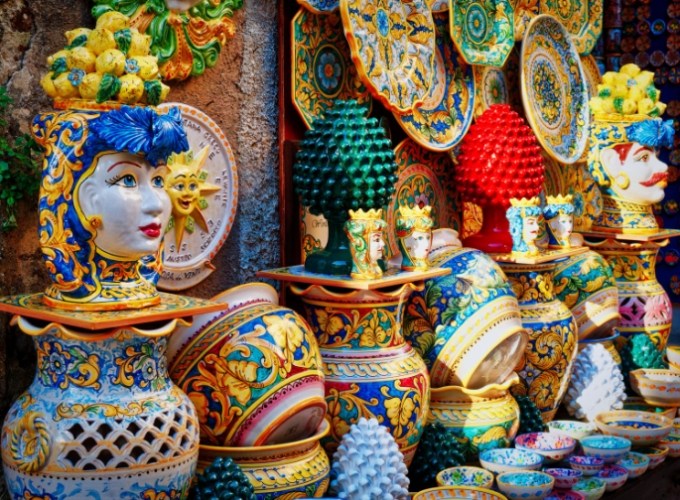
Origins and Influences
The story of Sicilian ceramics begins in ancient times, with roots tracing back to the Greek and Roman civilizations that once thrived on the island. These early settlers brought with them advanced techniques in pottery making, which were then influenced by the subsequent waves of conquerors and settlers, including the Arabs, Normans, and Spaniards. Each culture left its mark on Sicilian ceramics, creating a unique fusion of styles and motifs.
Ancient Greek and Roman Influence
- Techniques: The Greeks introduced the use of the potter's wheel and high-temperature firing, which allowed for the creation of durable and finely crafted vessels.
- Motifs: Geometric patterns and mythological scenes were popular, reflecting the artistic tastes of the time.
Arab Influence
- Colors and Designs: The Arabs introduced vibrant colors like cobalt blue, turquoise, and manganese purple, as well as intricate geometric and floral designs.
- Glazing Techniques: They perfected the art of lead-glazing, which gave ceramics a glossy finish and enhanced their durability.
Norman and Spanish Influence
- Styles: The Normans brought a more utilitarian approach, focusing on functional items like jugs and plates. The Spaniards, on the other hand, introduced new shapes and decorative elements, such as the iconic "Majolica" style.
Evolution Over the Centuries
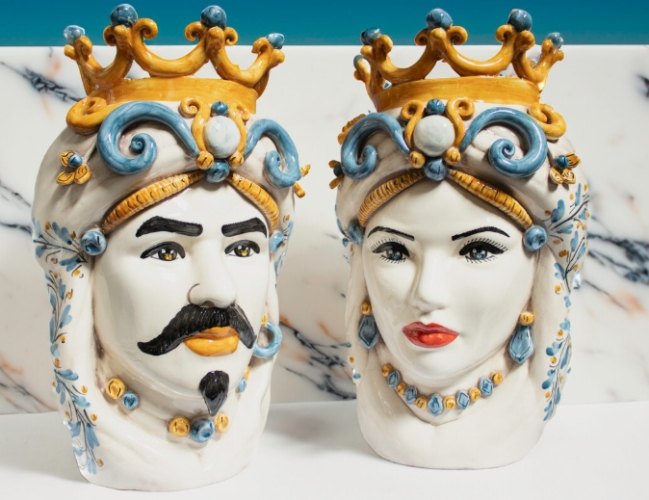
Throughout the Middle Ages and Renaissance, Sicilian ceramics continued to evolve, influenced by the changing political and cultural landscape of the island. The 18th and 19th centuries saw a revival of interest in traditional crafts, leading to the establishment of numerous workshops and the development of distinct regional styles.
Regional Styles
- Caltagirone: Known for its "Caltagirone Majolica," this town is famous for its vibrant colors and intricate designs, often featuring animals, flowers, and mythological figures.
- Santo Stefano di Camastra: This town specializes in "Santo Stefano Ceramics," characterized by their bold, geometric patterns and use of bright colors.
- Sciacca: Sciacca ceramics are known for their delicate, hand-painted designs and the use of traditional motifs like fish, shells, and maritime scenes.
Core Craftsmanship of Sicilian Ceramics
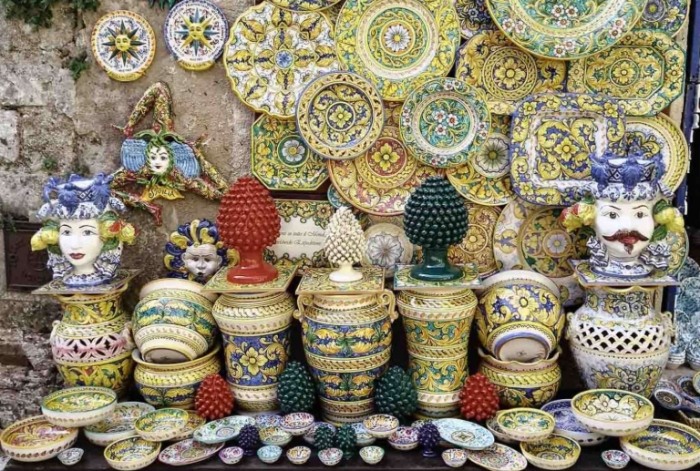
Materials and Tools
The production of Sicilian ceramics begins with the selection of high-quality clay, often sourced from local quarries. The clay is then mixed with water and other minerals to create a workable paste. Potters use a variety of tools, including the potter's wheel, shaping tools, and brushes, to shape and decorate the ceramics.
Clay Selection
- Types: Different types of clay are used depending on the desired texture and finish. For example, "terra cotta" clay is often used for functional items, while "porcelain" clay is used for more delicate pieces.
- Processing: The clay is cleaned, kneaded, and aged to improve its workability and strength.
Glazing and Firing
- Glazing: After shaping, the ceramics are glazed using a mixture of minerals and water. The glaze is applied in multiple layers to achieve the desired color and texture.
- Firing: The glazed ceramics are then fired in a kiln at high temperatures, typically between 900°C and 1200°C. This process hardens the clay and fuses the glaze, creating a durable and waterproof finish.
Decorative Techniques
Sicilian ceramics are renowned for their intricate and colorful decorations. Potters use a variety of techniques to create these designs, including hand-painting, stenciling, and transfer printing.
Hand-Painting
- Tools: Potters use fine brushes and natural pigments to create detailed designs on the ceramics.
- Styles: Designs often feature traditional motifs like flowers, animals, and geometric patterns, as well as scenes from daily life and mythology.
Stenciling
- Process: Stencils are used to create consistent and repeatable designs. The stencil is placed on the ceramic, and the pigment is applied through the cutouts.
- Advantages: Stenciling allows for the creation of complex designs with a high level of precision.
Transfer Printing
- Technique: Designs are printed onto transfer paper and then applied to the ceramic. The transfer is then fired, bonding the design to the surface.
- Applications: Transfer printing is often used for mass-produced items, allowing for the replication of popular designs.
Shopping Guide for Sicilian Ceramics
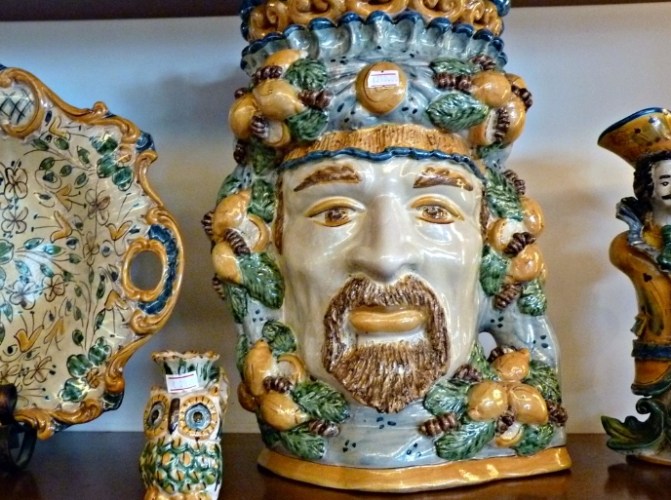
Where to Shop
Sicily is home to numerous workshops, markets, and boutiques where you can find a wide variety of ceramics. Whether you're looking for traditional pieces or modern interpretations, there's something for everyone.
Caltagirone
- Caltagirone Ceramics Market: This bustling market is a must-visit for anyone interested in Sicilian ceramics. You'll find a vast selection of items, from small trinkets to large vases, all crafted by local artisans.
- Workshops: Many workshops in Caltagirone offer tours and demonstrations, allowing you to see the ceramics being made firsthand.
Santo Stefano di Camastra
- Santo Stefano Ceramics Street: This charming street is lined with shops selling a variety of ceramics, from classic designs to contemporary pieces.
- Museums: The town also has several museums dedicated to the history and craftsmanship of Sicilian ceramics, providing a deeper understanding of the art form.
Palermo
- Vucciria Market: This historic market in Palermo is a great place to find unique ceramics, as well as other local crafts and souvenirs.
- Boutiques: Many boutiques in Palermo offer high-end ceramics, often featuring designs by renowned Sicilian artists.
What to Look For
When shopping for Sicilian ceramics, it's important to know what to look for to ensure you're getting a quality piece.
Authenticity
- Markings: Look for ceramics with the maker's mark or the town of origin stamped on the bottom. This indicates that the piece was made by a local artisan.
- Materials: Authentic Sicilian ceramics are made from high-quality clay and natural pigments, ensuring their durability and longevity.
Craftsmanship
- Detail: Pay attention to the level of detail in the decoration. High-quality ceramics will have intricate and well-executed designs.
- Finish: The glaze should be smooth and even, with no visible imperfections.
Price
- Value: While it's tempting to go for the cheapest option, remember that quality comes at a price. Invest in a piece that you'll cherish for years to come.
- Bargaining: In some markets, bargaining is expected. However, be respectful and remember that the artisans rely on their craft for a living.
Deep Cultural Experience with Sicilian Ceramics

Workshops and Demonstrations
One of the best ways to experience the art of Sicilian ceramics is by participating in a workshop or demonstration. Many workshops offer hands-on experiences, allowing you to try your hand at shaping clay, glazing, and painting.
Caltagirone Workshops
- Pottery Classes: Several workshops in Caltagirone offer pottery classes for all skill levels. You'll learn the basics of pottery making and have the opportunity to create your own piece.
- Demonstrations: Watch as skilled artisans demonstrate traditional techniques, sharing their knowledge and passion for the craft.
Santo Stefano di Camastra Workshops
- Stencil Making: Learn how to create your own stencils and use them to decorate ceramics. This is a great way to understand the process behind the intricate designs.
- Transfer Printing: Try your hand at transfer printing, a technique that allows for the replication of popular designs.
Cultural Festivals
Sicily is home to numerous cultural festivals that celebrate the island's rich heritage, including its ceramics. These festivals are a great opportunity to see the art in action and experience the vibrant culture of Sicily.
Caltagirone Ceramics Festival
- Date: Held annually in July, this festival is a celebration of Caltagirone's ceramics heritage.
- Highlights: The festival features parades, exhibitions, and workshops, as well as a grand finale where a massive ceramic staircase is illuminated with thousands of candles.
Santo Stefano di Camastra Ceramics Fair
- Date: This fair takes place in August and is a showcase of the town's ceramics industry.
- Activities: Visitors can browse stalls selling a variety of ceramics, watch live demonstrations, and participate in workshops.
Classic Products of Sicilian Ceramics
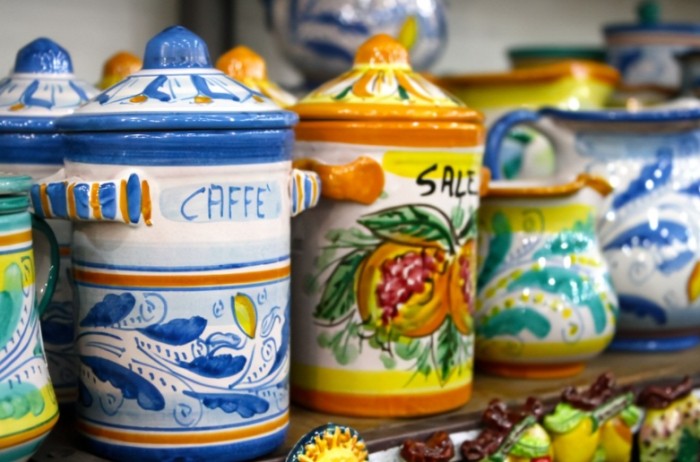
Tableware
Sicilian ceramics are renowned for their beautiful tableware, which adds a touch of elegance and charm to any dining experience.
Plates and Bowls
- Designs: Tableware often features traditional motifs like flowers, animals, and geometric patterns.
- Uses: Perfect for everyday use or special occasions, Sicilian tableware is both functional and decorative.
Jugs and Pitchers
- Shapes: Jugs and pitchers come in a variety of shapes and sizes, from small, decorative pieces to large, functional vessels.
- Decorations: These items are often decorated with intricate designs, making them a focal point of any table setting.
Decorative Items
In addition to tableware, Sicilian ceramics also include a wide range of decorative items that can add a touch of Sicilian charm to any home.
Vases and Urns
- Styles: Vases and urns come in a variety of styles, from classic to contemporary.
- Uses: These items are perfect for displaying flowers or as standalone decorative pieces.
Wall Hangings and Tiles
- Designs: Wall hangings and tiles often feature traditional Sicilian motifs, such as the "Trinacria" (the three-legged symbol of Sicily) or the "Moor's Head" (a symbol of the island's Arab heritage).
- Applications: These items can be used to decorate walls, fireplaces, or even outdoor spaces.
Functional Items
Sicilian ceramics also include a range of functional items that are both practical and beautiful.
Lamps and Lanterns
- Designs: Lamps and lanterns often feature intricate designs and vibrant colors, creating a warm and inviting atmosphere.
- Uses: These items are perfect for adding a touch of Sicilian charm to any room.
Planters and Pots
- Styles: Planters and pots come in a variety of styles, from traditional to modern.
- Uses: These items are perfect for displaying plants or flowers, both indoors and outdoors.
Q&A
1. What is the traditional ceramics of Sicily?
The traditional ceramics of Sicily are known for their vibrant colors, intricate designs, and high-quality craftsmanship. They are influenced by a blend of Greek, Roman, Arab, Norman, and Spanish cultures, resulting in a unique fusion of styles and motifs. Traditional Sicilian ceramics often feature designs like flowers, animals, geometric patterns, and scenes from daily life and mythology.
2. What town in Sicily is known for pottery?
Caltagirone is perhaps the most famous town in Sicily for pottery. Known for its "Caltagirone Majolica," this town is renowned for its vibrant colors, intricate designs, and high-quality ceramics. Visitors can explore the town's numerous workshops, markets, and museums dedicated to the art of pottery.
3. What are the ceramic heads in Sicily called?
The ceramic heads in Sicily are often referred to as "Moor's Heads" or "Teste di Moro." These iconic figures are a symbol of the island's Arab heritage and are often depicted as decapitated heads, often holding a flower or a fruit. They are a popular decorative item in Sicilian homes and are often used to add a touch of Sicilian charm to any space.
4. What city in Italy is famous for ceramics?
While Sicily is renowned for its ceramics, other cities in Italy are also famous for their ceramic traditions. For example, Faenza in Emilia-Romagna is known for its "Faenza Majolica," while Deruta in Umbria is famous for its "Deruta Ceramics." However, Sicily's unique blend of cultural influences and its vibrant, colorful designs make it a standout destination for ceramic enthusiasts.
In conclusion, Sicilian ceramics are a true testament to the island's rich cultural heritage and the skill and creativity of its artisans. Whether you're a collector, a decorator, or simply someone who appreciates fine craftsmanship, Sicilian ceramics offer a unique and timeless art form that is sure to captivate and inspire.